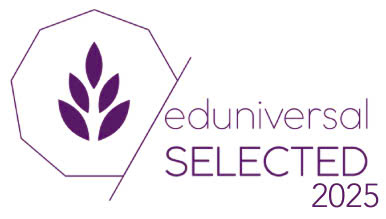- Eduniversal
-
-
Business Schools Ranking
-
Africa
- Algeria
- Angola
- Benin
- Cabo Verde
- Cameroon
- Congo
- Djibouti
- Egypt
- Eswatini
- Ethiopia
- Gabon
- Ghana
- Ivory Coast
- Kenya
- Lesotho
- Madagascar
- Malawi
- Mali
- Mauritania
- Mauritius
- Morocco
- Mozambique
- Namibia
- Nigeria
- RDC
- Rwanda
- Senegal
- Sierra Leone
- Somalia
- South Africa
- Sudan
- Tanzania
- Togo
- Tunisia
- Uganda
- Zambia
- Zimbabwe
- Central & Eastern Europe
- Central Asia
- Eurasia & Middle East
- Far East Asia
- Latin America
- North America
- Oceania
- Western Europe
-
Africa
- Schools of Excellence by field
- Awards
- News
- Contact
Summary:
This article explores the evolving landscape of U.S. business schools in 2025. It highlights major trends such as technological advancements, changing student and employer needs, and challenges in funding and talent acquisition. It also discusses new opportunities for growth through online learning, data analytics, and global partnerships.
Resilient Yet Complex Economic and Educational Landscape
The business school sector in the USA in 2025 operates within a strong yet complex economic and educational context characterized by resilient economic growth, evolving workforce demands, and significant technological transformation.
Business schools are integral to this landscape as they prepare future leaders and innovators who will navigate an increasingly dynamic and interconnected global economy.
The U.S. economy in 2025 is marked by above-trend growth, robust middle- and higher-income household spending power, but also uncertainty due to inflation and interest rate pressures that affect business operations and consumer confidence.
In this environment, business schools serve as critical incubators for skills and leadership development essential to sustaining both economic competitiveness and innovation.
Explore how business schools in other regions rise to economic challenges, such as those in Australia.
Technological Transformation and AI in Education
Digital Transformation and AI Integration
Artificial intelligence is reshaping both curriculum and delivery methods. Business schools are embedding AI-focused courses, certificates, and degree programs, aiming to upskill mid-career professionals and future-proof graduates for technology-driven markets.
AI also personalizes online learning experiences, making education more adaptive and accessible.
This mirrors similar initiatives taking place globally, such as the growing emphasis on AI in markets like Japan.
Meeting the Evolving Needs of Learners and Employers
Evolving Learner and Employer Expectations
Students increasingly demand flexibility, relevance, and demonstrable career impact. Employers assert that many graduates lack critical durable skills such as adaptability, problem-solving in ambiguous conditions, and entrepreneurial thinking.
Business programs are thus focusing on teaching how to think rather than what to think and embedding experiential learning and co-curricular activities to bridge this gap.
These priorities are reflected in other international regions, such as business schools in Colombia and Morocco, where demand for soft skills is reshaping education models.
Expanding Global Footprints and International Collaboration
Globalization and Internationalization
Despite geopolitical uncertainties, U.S. business schools remain global hubs attracting international talent. There is growing emphasis on international MBA programs and global corporate partnerships to diversify recruitment and expand learning opportunities.
Such cross-border educational efforts find parallels in nations such as the United Kingdom, where institutions similarly build global partnerships to enhance learning and diversity.
Embracing Sustainability and Social Responsibility
Sustainability and Social Impact
Ethical leadership and environmental, social, and governance (ESG) considerations are increasingly prominent in curricula. Business schools are prioritizing sustainability as a domain of expertise and a lens through which all business disciplines are taught.
Countries like France are also integrating sustainability into business education, reflecting a global shift towards responsible management education.
Navigating Institutional and Financial Challenges
Financial Pressures and Competitiveness
Amid reduced public funding and rising operating costs—including healthcare and mental health support—business schools face intense competition and financial constraints. Institutions are challenged to invest in infrastructure and innovative programs while maintaining affordability and accessibility.
Challenges facing business schools:
- Funding and Resource Constraints: Declining public funding combined with rising operational costs force schools to prioritize financial resilience, often requiring new revenue streams such as online certificates and executive education.
- Attracting and Retaining Talent: Intense competition for top faculty with expertise in emerging fields like AI and sustainability demands strategic leadership and innovative recruitment practices.
- Adapting to Workforce Needs: Rapidly changing skills requirements driven by technological advances and shifting economic conditions put pressure on schools to continuously update curricula and teaching methods.
- Navigating Geopolitical and Demographic Shifts: Political uncertainty affects international student mobility and recruitment strategies, complicating schools’ efforts to diversify and globalize their cohorts.
Discover how institutions in Canada are managing similar funding and faculty recruitment challenges.
Unlocking Innovation and Future Opportunities
Opportunities and Innovations Ahead
- Expansion of Online and Hybrid Learning: The growth in online certificates and tailored micro-credentials offers scalable, flexible pathways for lifelong learning and upskilling, appealing to working professionals.
- Leveraging Data and Analytics: Schools with robust, trusted data on graduate outcomes can demonstrate return on investment to students and funders, enhancing reputation and recruitment.
- Enhanced Corporate Partnerships: Collaborations with industry can provide experiential learning, research opportunities, and pathways to employment, responding to employer demands and strengthening communities.
- Focus on Resilience and Agility: Institutions embracing entrepreneurial mindsets, agile leadership, and innovative program delivery are better positioned to thrive amid uncertainty and shifting market needs.
Business schools in Singapore are also leading in creating agile, tech-enabled education models that adapt quickly to market needs.
Strategic Vision for Long-term Relevance
In the context of the U.S.’s dynamic economy and leadership in innovation, business schools must double down on cultivating flexible, ethical, and digitally savvy leaders capable of navigating complexity and change.
By embedding emerging technologies like AI, prioritizing relevant and durable skills, expanding access through online platforms, and proactively addressing financial and demographic challenges, these institutions can not only maintain their relevance but also accelerate positive transformation in business education.
This moment demands a strategic vision and coordinated action: business schools as critical pillars of economic growth and social progress must rethink traditional models and collaborate across academia, industry, and government.
Embracing this challenge will empower the next generation of leaders to build resilient businesses and thriving communities amid the uncertainties of the mid-21st century.
To explore more about U.S. institutions and how they compare globally, visit our comprehensive ranking of business schools in the U.S.A.
Business Schools Ranking in U.S.A.
|
5 Palmes Emeritus Universal Business Schools with over a decade of continuous excellence |
Rank Position in
Palmes’ League |
Deans’ Recommendation
rate 2025 |
|---|---|---|
| 739 ‰ FEATURED | ||
| 703 ‰ FEATURED | ||
| 583 ‰ FEATURED | ||
| 567 ‰ FEATURED | ||
| 534 ‰ | ||
|
Cornell University Samuel Curtis Johnson Graduate School Of Management |
480 ‰ | |
| 480 ‰ | ||
| 470 ‰ | ||
| 454 ‰ | ||
|
New York University (Nyu) Leonard N. Stern School Of Business |
439 ‰ | |
| 429 ‰ | ||
| 411 ‰ | ||
| 403 ‰ | ||
| 349 ‰ | ||
| 334 ‰ | ||
| 321 ‰ | ||
|
University Of California - Los Angeles (Ucla) John E. Anderson School Of Management |
318 ‰ |
|
5 Palmes of Excellence Universal Business Schools with strong global influence |
Rank Position in
Palmes’ League |
Deans’ Recommendation
rate 2025 |
|---|---|---|
|
GW School of Business | The George Washington University (1) |
1 | 198 ‰ FEATURED |
(1) Upgrade league has been approved in 2025 by the Eduniversal International Scientific Committee |
|
2 Palmes of Excellence Good Business Schools with strong regional influence |
Rank Position in
Palmes’ League |
Deans’ Recommendation
rate 2025 |
|---|---|---|
| 1 | 103 ‰ | |
|
California State University - Long Beach College of Business Administration |
2 | 87 ‰ |
| 3 | 49 ‰ | |
|
The University of North Dakota College of Business & Public Administration |
4 | 36 ‰ |
|
University of Alaska Anchorage - UAA College of Business and Public Policy |
5 | 33 ‰ |
|
Southern Illinois University Carbondale - SIU College of Business |
6 | 31 ‰ |
| 7 | 26 ‰ | |
| 8 | 10 ‰ |
|
1 Palme of Excellence Business Schools with considerable local influence |
Rank Position in
Palmes’ League |
Deans’ Recommendation
rate 2025 |
|---|---|---|
| - FEATURED |
(*) New institution approved by the ISC to enter in the 2025 Eduniversal Official Selection |
The Eduniversal Selected Schools list aims to highlight institutions by country are not yet eligible for a Palmes of Excellence League entry but are on a positive path toward achieving it.
The schools on the Eduniversal Selected list have been recognized by Eduniversal for their innovative projects, disruptive energy, and growing potential.
The schools on the Eduniversal Selected list have been recognized by Eduniversal for their innovative projects, disruptive energy, and growing potential.
A. R. Sanchez, Jr. School of Business- Texas A&M International University
Albers School of Business and Economics- Seattle University
Anisfield School of Business- Ramapo College of New Jersey
Argyros School of Business and Economics- Chapman University
Arthur J. Bauernfeind College of Business- Murray State University
Atkinson Graduate School of Management- Willamette University
Barney Barnett School of Business& Free Enterprise- Florida Southern College
Binghamton University, State University of New York
Boler School of Business- John Carroll University
Brock School of Business- Samford University
Bryan School of Business & Economics- The University of North Carolina at Greensboro
Business School- University of Colorado Denver
C.T. Bauer School of Business- University of Houston
Campbell School of Business- Berry College
Coles College of Business- Kennesaw State University
College of Business - Florida International University
College of Business - The University of Texas at Arlington
College of Business Administration - California State University, Sacramento
College of Business Administration- The University of Texas at El Paso
College of Business Administration- University of Central Florida
College of Business Administration- University of Illinois at Chicago
College of Business Administration- University of Wisconsin-La Crosse
College of Business Administration-Central Michigan University
College of Business Administration-Georgia Southern University
College of Business Administration-Sam Houston State University
College of Business and Economics- California State University, Los Angeles
College of Business and Natural Sciences- Black Hills State University
College of Business- Arkansas State University
College of Business- Bryant University
College of Business- Delaware State University
College of Business- Duquesne University
College of Business- Florida State University
College of Business- Idaho State University
College of Business- Iowa State University
College of Business- Jackson State University
College of Business- James Madison University
College of Business- King's College
College of Business- Loyola University New Orleans
College of Business- Metropolitan State University of Denver
College of Business- Northern Michigan University
College of Business- Ohio Northern University
College of Business- Ohio University
College of Business- Oregon State University
College of Business- Purdue University Calumet
College of Business- San Francisco State University
College of Business- Stetson University
College of Business- Texas A&M University-Corpus Christi
College of Business- The University of Akron
College of Business- University of Colorado Colorado Springs
College of Business- University of West Florida
College of Business- University of Wisconsin-Eau Claire
College of Business-Colorado State University
College of Business-Louisiana Tech University
College of Business-University of Wisconsin Oshkosh
College of Business, Economics, and Computing- University of Wisconsin-Parkside
Craig School of Business- California State University, Fresno
Culverhouse College of Commerce- The University of Alabama
Davis School of Business- University of Houston-Downtown
Else School of Management- Millsaps College
Gordon Ford School of Business-Western Kentucky University
Graham School of Management- Saint Xavier University
Greehey School of Business- St. Mary's University
Haworth College of Business- Western Michigan University
International Business School- Brandeis University
John Massey School of Business- Southeastern Oklahoma State University
Martha& Spencer Love School of Business- Elon University
Merrick School of Business-University of Baltimore
Monte Ahuja College of Business- Cleveland State University
Naval Postgraduate School
Nichols College
Poole College of Management- North Carolina State University
Rawls College of Business-Texas Tech University
School of Business Administration- Gonzaga University
School of Business Administration- Texas Wesleyan University
School of Business Administration- The Pennsylvania State University at Harrisburg
School of Business Administration- The University of Mississippi
School of Business Administration- University of Dayton
School of Business- Clarkson University
School of Business- Siena College
School of Business- Stevens Institute of Technology
School of Business- Virginia Commonwealth University
School of Business- Woodbury University
School of Business-Francis Marion University
School of Business-La Salle University
School of Business-Long Island University-Post (Campus)
School of Business-Manhattan College
School of Business-Oakland University
School of Business-Southern Utah University
School of Business-Texas Christian University
School of Business-University of Kansas
School of Business-Wayne State University
School of Management- Bucknell University
School of Management- Clark University
Schroeder School of Business- University of Evansville
State University of New York - Farmingdale School of Business
Texas State University
The Feliciano School of Business- Montclair State University
The University of North Carolina at Asheville
University of California, San Diego
University of Massachusetts Boston
Williams School of Commerce, Economic, and Politics- Washington and Lee University
Woodbury School of Business- Utah Valley University
For a complete overview of master’s programs in U.S.A., visit our website.
You’ll find updated rankings, detailed program profiles, and exclusive advice to help you choose the right path for your career.
You’ll find updated rankings, detailed program profiles, and exclusive advice to help you choose the right path for your career.








